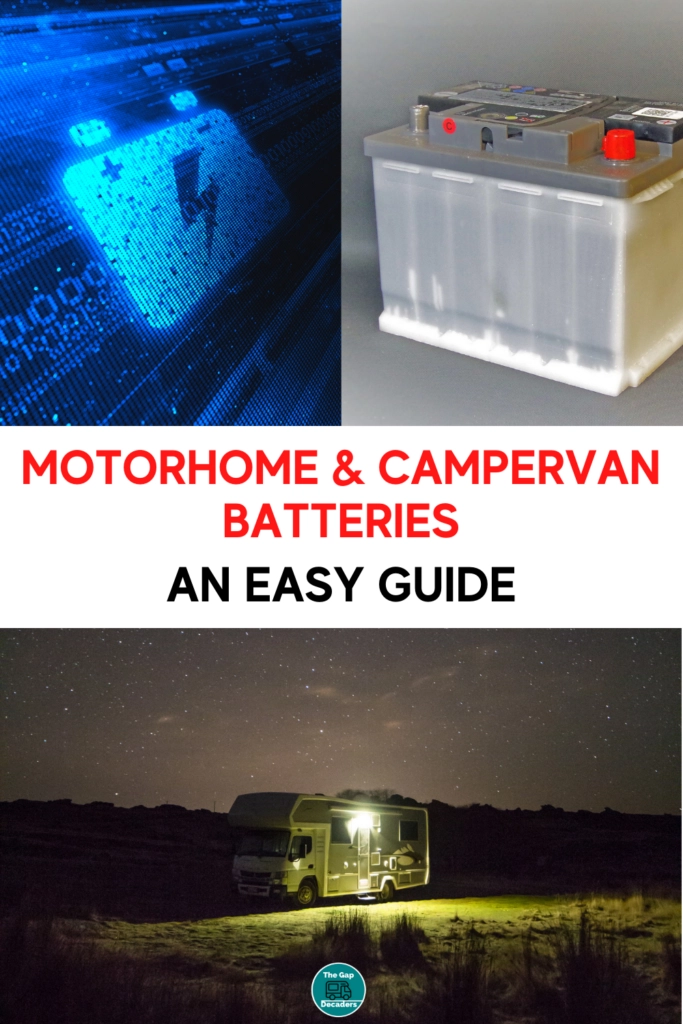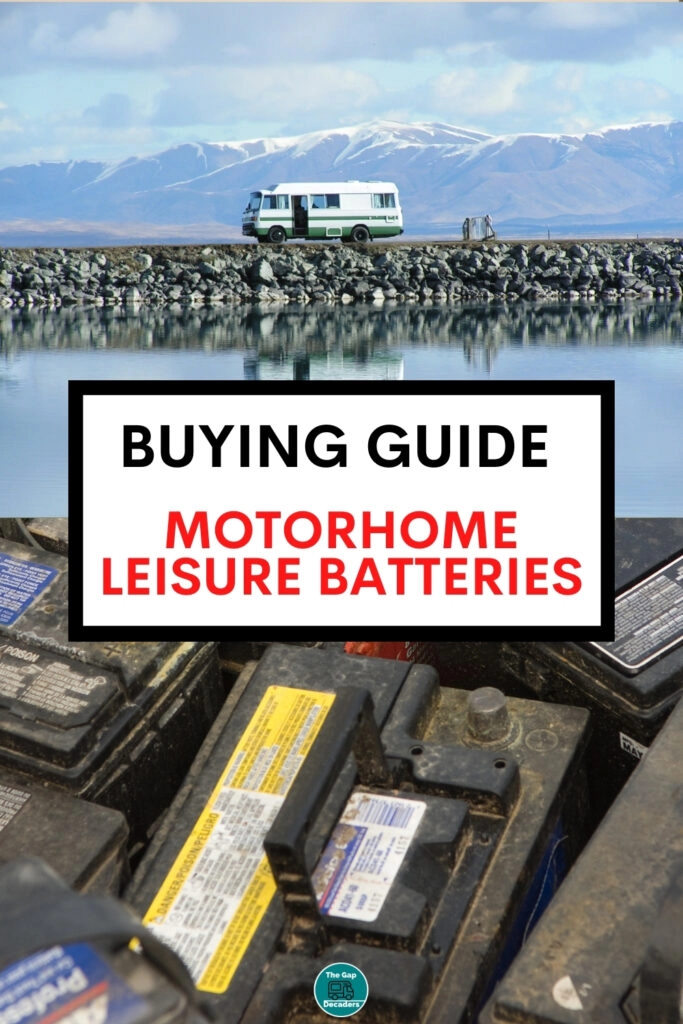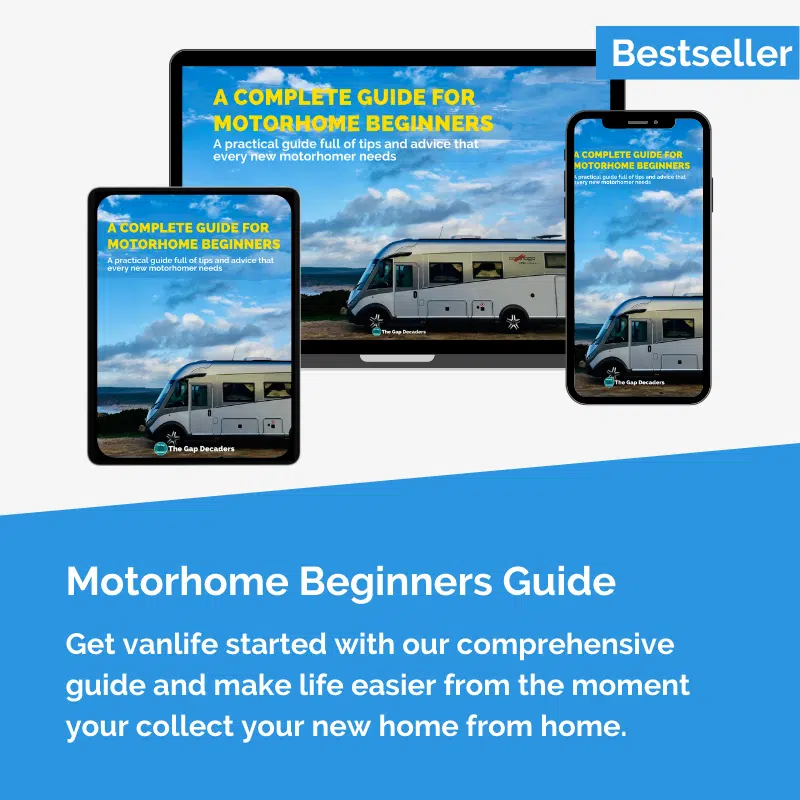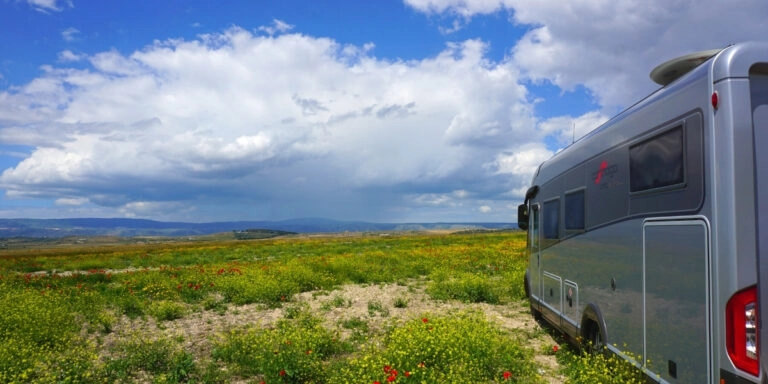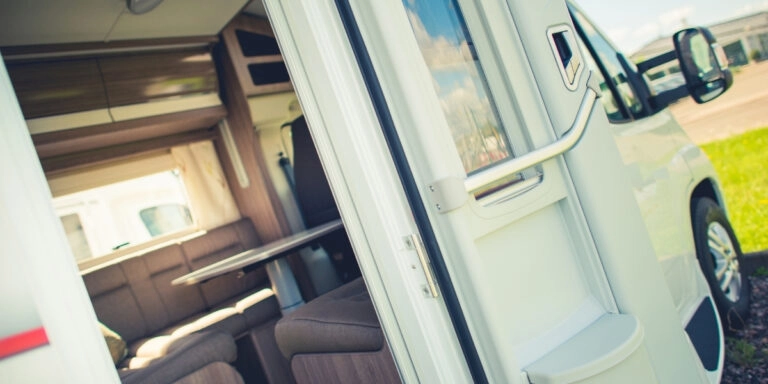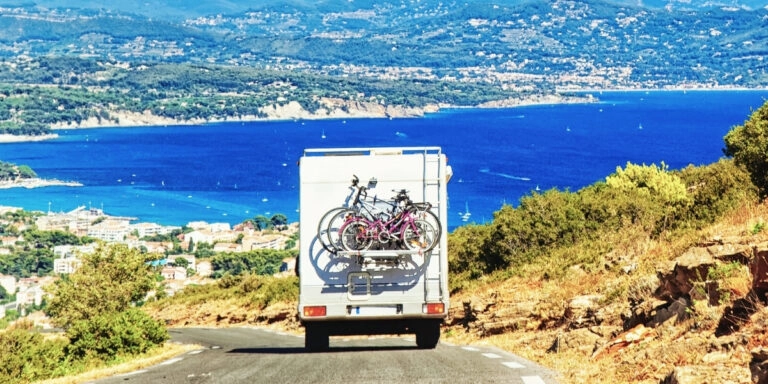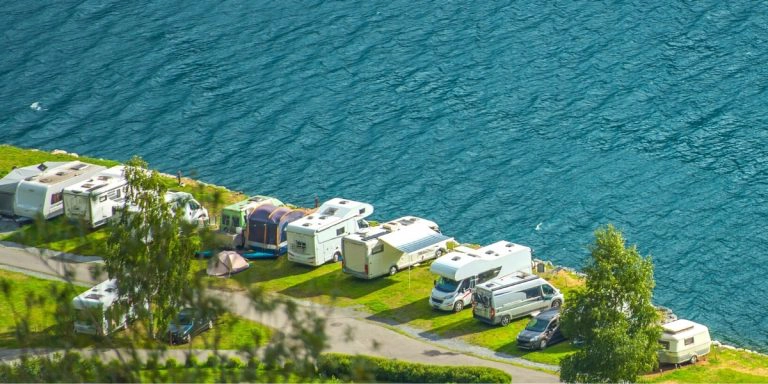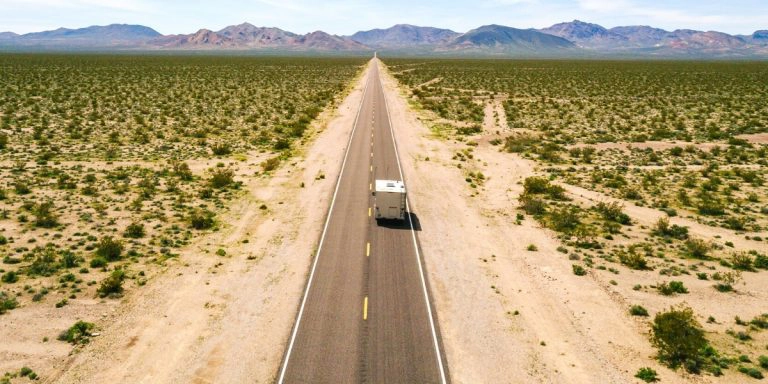This post may contain affiliate links, from which we earn an income. Click here to read our affiliate policy.
Motorhome & Campervan Leisure Batteries – Everything You Need to Know!
Any home on wheels needs a leisure battery to keep the habitation area supplied with electricity. There are many different types of leisure batteries and charging methods – our easy guide to motorhome leisure batteries has all the information you need to understand battery systems, and choose the right batteries for your van.
We all want the comforts of home in our vans – stuff like charging devices, watching tv or listening to music. If you like to camp off grid where EHU (electric hook up) isn’t available, then a reliable power source is important, even if it’s just to have your lights on after dark.
If you get it right though, you can have so much more than that. If you want to power speakers, gadgets, fridges, laptops and even your washing machine and e bike, it’s possible with the right leisure battery set-up, just follow our buying guide.
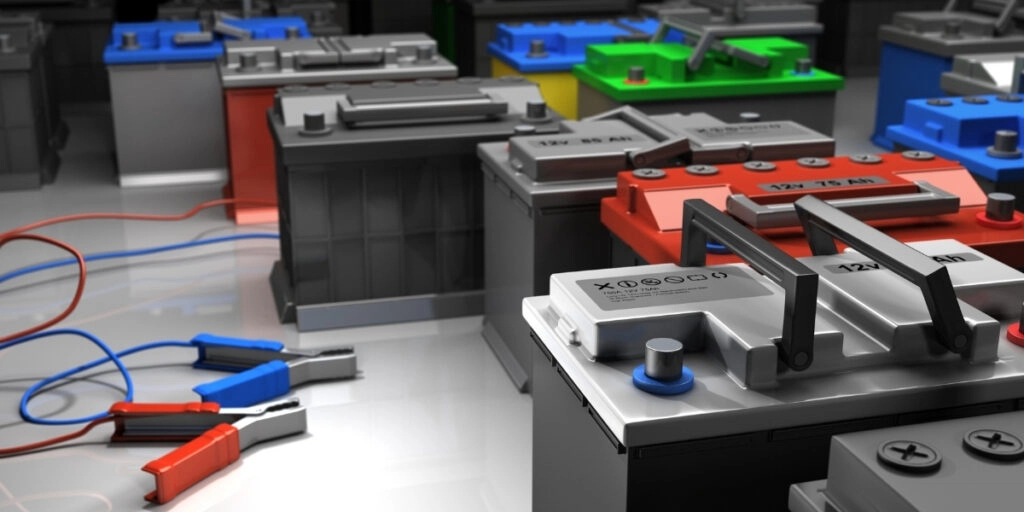
Types of Batteries
All motor caravans, RV’s and converted vehicles designed for habitation have two types of battery.
Starter Battery
The starter battery or car battery is what starts your vehicles engine. Most campervan and motorhome engine batteries are 12V. If you have a converted lorry or overland truck then it’s likely that your starter battery will be 24V.
When you start your van’s ignition, a signal is sent to the starter battery. When the signal is received, the battery converts chemical energy into electrical energy and this electrical power is delivered to the starter to crank the engine (that’s why sometimes its called a crank battery). The car batteries also provides power to the cab lights and other accessories such as cab air conditioning.
Leisure Battery
A deep cycle leisure battery, sometimes called a house battery, runs on a deep cycle and is designed to efficiently discharge a low and stable current over a long period of time.
Constructed using thicker battery plates and a denser active material than an engine battery, a leisure battery can withstand repeated charge and discharge cycles throughout its lifetime. Some deep cycle battery types have a Depth of Discharge (DoD) rate as high as 80% before they require re-charging.
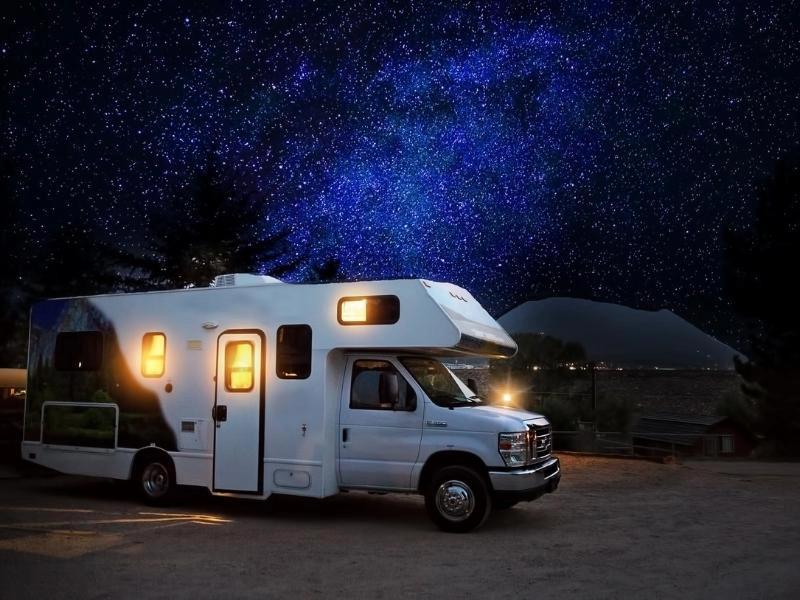
Leisure Battery Specifications
Let’s say you’ve got a deep cycle battery with the following specifications:
120Ah at 20 hours, rated 1000 full cycles at 80% DoD
What do all those numbers and abbreviations mean?
Battery Capacity
The Amp-hour (Ah) denotes the battery capacity and shows how much current can be delivered for a specific time.
A 120Ah battery at 20 hours means it can produce 6 amps for 20 hours (120/20 = 6). Deep cycle batteries are typically rated for a 20 hour discharge.
An easy way to work out whether the amp hours will be sufficient is to add all the amps up for each device or appliance you will be using at the same time. You can find out the amps by using this formula; watts/volts = amps.
It’s a crude way of working out the draw on the battery, but this won’t tell you how long the battery will last. This nifty calculator can work that out for you.
Fundamentally, the more appliances you want to power, the higher battery capacity you’ll need. Our current motorhome has 220ah across two batteries and our new expedition truck has a battery bank of 420ah across three batteries.
Discharge Cycle
The discharge cycle specifies how many times a battery can be discharged and charged without reducing performance or capacity.
1000 full cycles simply means it can be charged and discharged 1000 times. The more full cycles there are, the longer the battery life.
Deep cycle batteries generally last five to six years with proper care and maintenance. Gel and lithium batteries can last up to ten years.
Depth Of Discharge
Depth of Discharge determines how much of the battery can be discharged safely compared to its original capacity, before it must be recharged.
Deep cycle batteries are meant to discharge more of their energy. An 80% DoD means the battery can discharge down to 20% of its capacity.
Types of Leisure Batteries
Flooded Lead Acid
The standard flooded lead acid battery is the oldest battery type still in use.
In this type of FLA leisure battery, lead plates are submerged in an electrolyte mix of water and sulfuric acid. A chemical reaction during charging and discharging produces gases that are vented from the battery, which in turn creates a drop in the electrolyte level, which needs to be regularly checked and topped up.
You can also get flooded lead acid batteries which are sealed and sold as being maintenance free.
The usable capacity of a battery indicates how much of the battery can be used before it must be recharged. The usable capacity of a flooded lead acid battery is around 30-50% of the total capacity.
Charging a flooded battery happens in stages, which means undercharging or overcharging is common. On average, the charging efficiency of the flooded battery is around 70-85%.
While the flooded battery is an affordable option it requires proper ventilation, must always be upright (to avoid electrolyte leakage), and needs the most maintenance. It also has a shorter lifespan compared to other types.
You can check if your van has and acid leisure battery by reading the label – look for “wet cell”, “flooded lead acid”, “lead acid”, or “liquid lead acid”. The battery will also have caps or removable tops.
Caution – be very careful with open lead acid batteries. The acid in the battery will burn human tissue. If the acid comes into contact with seawater, chlorine gas is produced.
If you’re looking to buy and FLA battery, check out these brands – Banner; Bosch; Exide; Leoch; Varta and Xplorer.
Absorbent Glass Mat (AGM)
The AGM leisure battery (similar to the less popular lead crystal battery) is a type of Valve Regulated Lead Acid (VRLA) battery.
The name Absorbent Glass Matt refers to the fiberglass mats placed between the lead plates. The glass mat absorbs electrolyte, stopping it from moving and spilling, and acts as a damper between the lead plates.
The damping action of the glass mat makes the battery vibration and shock resistant, and also able to withstand cold temperatures.
The AGM deep cycle battery has low internal resistance and charges faster than either a gel or flooded battery. It has a 95% charge efficiency and an 80% Depth of Discharge.
An AGM battery has lots of advantages include being maintenance free, durable and fast-charging. It can also be placed in any position as there is no risk of spillage. AGM batteries are more expensive than flooded cell batteries and are sensitive to overcharging, so it needs a regulated charger to be fitted.
You can check if your van has an AGM leisure battery by reading the label – look for “AGM”, “Absorbed Glass Mat”, “dry cell”, “sealed regulated valve”, “non-spillable,” or “valve regulated” on the label. AGM batteries have flat tops except for the positive and negative terminals.
If you’re looking to buy an AGM battery, check out these brands – Banner; Exide; Varta and Xplorer.
Gel Cell
The gel cell battery is another type of VRLA battery.
Gel batteries use a gelled electrolyte, formed from sulfuric acid and water suspended in a silica agent.
The gel battery has a charge efficiency of around 85-90%, with superb heat tolerance and no off-gassing.
But gel batteries can’t withstand fast charging and they are also very sensitive to overcharging, which can cause irreparable damage.
Gel leisure batteries are maintenance free, spill-proof and position insensitive. But they are also more expensive than flooded or AGM batteries and will require a special charger and regulator.
You can check if your van has a gel leisure battery by looking for the words “gel filled” on the label. Gel cell batteries also have flat tops except for the positive and negative terminals.
If you’re looking to buy an gel battery, check out these brands – Exide and Leoch.
Lithium Batteries
The lithium iron (so called because it used the metal iron in its chemistry) phosphate battery is a relative newcomer compared to lead acid battery varieties and for many, the LiFePO4 12V lithium ultra deep cycle battery is considered the best leisure battery to fit, funds permitting!
A lithium battery is 30% lighter than a flooded cell battery and will have a usable capacity of 80-100%. A lithium leisure battery will also provide constant voltage at any discharge rate. They also have the fastest recharge rate and an extremely long life at around 2000-5000 charge cycles.
Lithium ion batteries or Li-ion batteries are used to power phones, laptops, e bikes and hybrid and electric cars. They are slightly different from Lithium iron batteries in the way they work, hence the different name.
Lithium deep cycle batteries are lightweight, compact and maintenance free with excellent usable capacity, a fast recharge rate and constant voltage. The downside is that lithium leisure batteries are much more expensive, about three times the price of AGM batteries, and need a battery management system (BMS), which pushes the overall price up even higher, although newer makes have this built-in so it comes as part of the battery.
If you’re looking to buy a lithium battery, check out these brands – Mastervolt; Leoch; Relion and Valence.
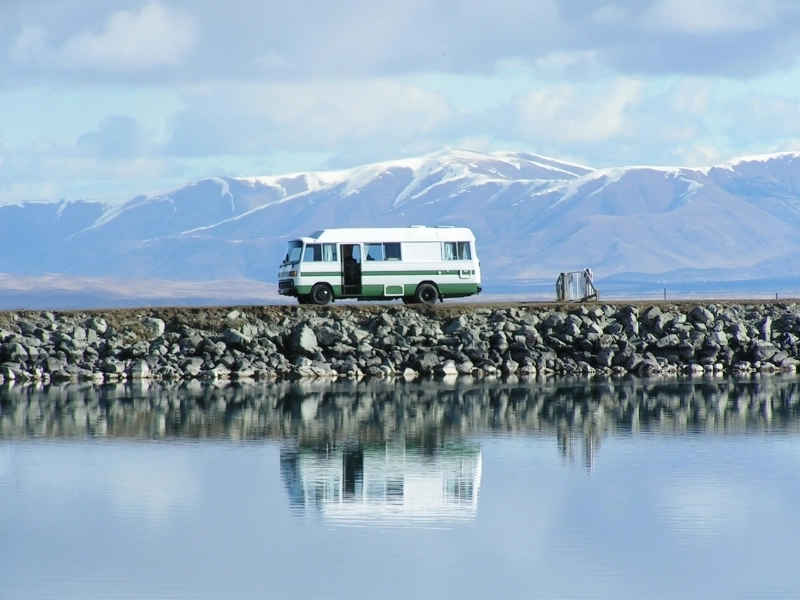
Useful Motorhoming Resources
Leisure Battery Charging
All leisure batteries can be charged in a number of ways.
Starter Battery
Most motorhome and camper van batteries are set up to be charged from the engine battery when the engine is running. This type of set-up allows a specially designed voltage sensitive relay to connect the leisure battery to the vehicle alternator, in parallel to your engine battery.
The split charge relay prioritises the engine battery and automatically switches to the leisure battery once the engine battery is fully charged. This means your leisure battery is kept topped up as you drive, but cannot be overcharged, as the relay prevents the leisure batteries taking a charge from the starter battery when the engine is switched off.
Mains Power
Whenever you check in to a campsite, you can use electric hook up (EHU) to power your habitation area and leisure battery. When you plug in, the 230V on-board power circuit in your van springs to life and your three pin sockets become live.
Everything powered by 12V still works and you have the advantage of the 230V EHU also powering your leisure battery.
The Complete Guide for Motorhome Beginners
With our best motorhome tips and advice about motorhome basics to where to park for the night and ideas for touring Europe, this is the ultimate resource for motorhome newbies.
This motorhoming ebook will help you get to grips with the inner workings of your motorhome, giving you confidence for life on the road and your first motorhome adventure!
Solar Power
If you have a solar panel on your roof, or carry a large portable one, this also provides power to your leisure battery. If you have enough solar panels and battery amp hours, you can travel without ever having to plug in.
You will need to use a solar charge controller or regulator to regulate the incoming solar charge.
There are three types of regulator, with the most basic simply switching off when a set battery voltage is reached. Reconnection takes place when a second, lower, voltage is reached. The limitation of this basic system is that the average charge level is unlikely to exceed 85%.
Pulse Width Modulation (PWM) solar chargers are more efficient and improve battery performance and life. PWM regulators use advanced technology which varies how the charge is supplied, according to the level of charge in the battery. Once the battery is almost fully charged, the regulator provides a trickle charge to keep the battery topped up during periods of excess solar energy.
MPPT charge controllers are the most sophisticated, using maximum power point tracking technology. These devices use algorithms to allow solar panels to operate at their maximum power for a given set of temperature and light conditions.
An MPPT based charger can achieve average battery charge levels of 90 to 95%. MPPT’s come into their own in winter and on cloudy days.
Generator Power
Most portable generators have a 12V DC output for battery charging. This can be a quick way of getting power into a battery when you’re wild camping, but it’s not easy to know the rate of charge or battery voltage.
To overcome this, plug your campervan or motorhome into the 230V socket on the generator and charge the battery as you would when plugging in to EHU. Care is needed to ensure the generator is producing a steady output.
Portable generators are fine for short periods of charging or emergency charging, but you may seriously upset any other van lifers trying to enjoy that idyllicaly quiet spot!
Portable Charger
A portable leisure battery charger will provide emergency power to your leisure batteries, and can also help you manage your batteries when your motorhome is in winter storage. The best models are intelligent or smart chargers which can literally be turned on, plugged in and left to their own devices.
Wind Power
A staple for off-grid property owners, a wind turbine is a great source of power. Smaller turbines which can be dismantled for stowing are starting to emerge onto the market and may be a way of powering the motorhome leisure batteries of the future.
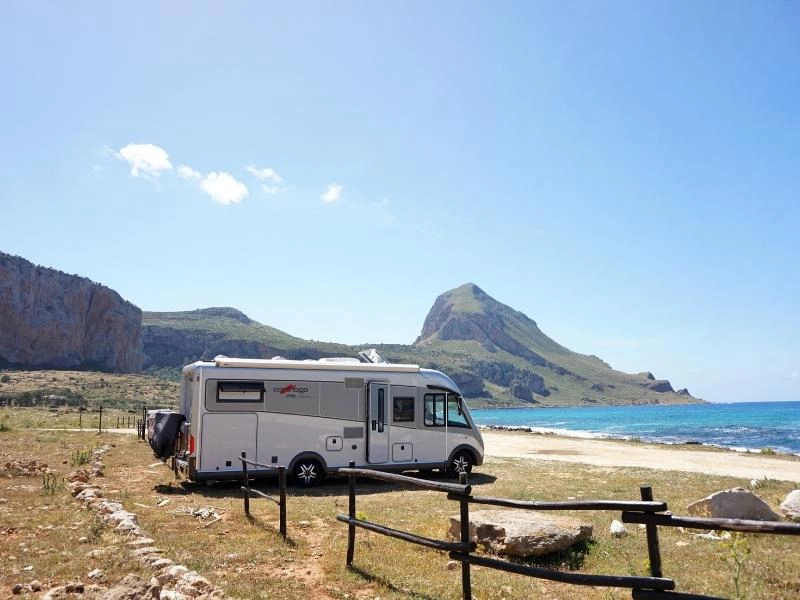
Replacing Leisure Batteries
Do I Need a New Leisure Battery?
How do you know when you need to replace your leisure batteries? There are usually a couple of tell-tale signs:
Your battery has boiled: When this happens the battery will give off a sulphurous or rotten egg smell and may become extremely hot. Both these signs usually mean the battery is being overcharged and is in danger of irreversible or permanent damage. Isolate and allow the battery to cool down. There may be spilled battery fluid and explosive gasses, so make sure to wear gloves and take extreme care when removing the dead battery.
Your batteries are too old to function efficiently: You’ll know this is the case because as soon as you turn something on (like the water pump) the voltage drops below 12V, or after a full charge the voltage remains below 12.6V.
Choosing a New Leisure Battery
If you’re simply looking for a replacement battery, it is often easier to just purchase like for like. If that’s not possible, or you’re looking to upgrade, you should consider the following:
Can a Lithium LifePO4 Battery Drop In to Replace a Lead Acid Battery?
Lots of places advertised LifePO4 lithium batteris as a ‘drop in’ replacement for lead acid batteries. It is true that the charging parameters are similar, but there are other things to consider too.
- Ideally, you need to be able to adjust the charging voltage of the battery in your chargers, especially if you are using a solar charger, as lithium batteries do not need to go through the same bulk, float and absorption cycle as lead acid. Your new batteries would still work if you were unable to do this, but they wouldn’t be as efficient and their life cycle might be compromised.
- If you use a split charge relay to charge your leisure batteries from the engine battery, this will need to be changed to a DC battery to battery charger. Split charge relays do not manage the current well and lithium batteries will also attempt to pull more amps than your alternator may be able to give, especially when the engine is idling. This can damage both battery and alternator.
- Lithium batteries cannot be charged at less than 5 degrees celcius. Although most now have an integral battery management system, this will only protect from overcharging, not charging when the ambient temperature is too low. Your new batteries will need to be well insulated to ensure they remain above freezing. You can also fit a sensor to your battery monitor which can alert you when the batteries are below the safe charging parameters.
How to Install a Replacement Leisure Battery
- Prior to actual disconnection, turn off the main control panel in the van and any isolation switches wherever the batteries are located (there may not be any).
- Disconnect the inverter, if you have one.
- Isolate solar panels from their regulator, if you have them fitted.
- If your van is on EHU, then unplug.
- Removing the battery by disconnect the negative lead first (black) and then the positive lead (red).
- Lift out the old battery – you may need to un-strap or un-secure it.
- Place and connect your new battery, connecting the positive terminal first and then negative.
- Turn everything you disconnected and isolated back on.
- Bear in mind that all new batteries require several charge and discharge cycles to reach full capacity.
- Make sure to dispose of old batteries correctly.
Deep Cycle Battery Maintenance
The longevity of a motorhome or campervan leisure battery depends on frequency of discharge, depth of discharge and how soon it is recharged. A regulator or controller will ensure your battery runs through this charge and discharge cycle regularly.
Follow our tips to keep your deep cycle battery in optimal condition:
Are you looking for more motorhome resources? Check out these top posts…
Motorhoming Made Easy – Your Top 20 Questions Answered
Motorhome Habitation Checks – All You Need to Know
The Best Motorhome Bike Racks & Bikes
Campervan or Motorhome? Which Is Right For You?
Motorhome Sat Navs: Best Models & Options for 2024
Motorhome TV: Six Ways to Get TV in Your Van
Love it? Pin it!
